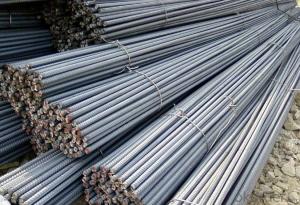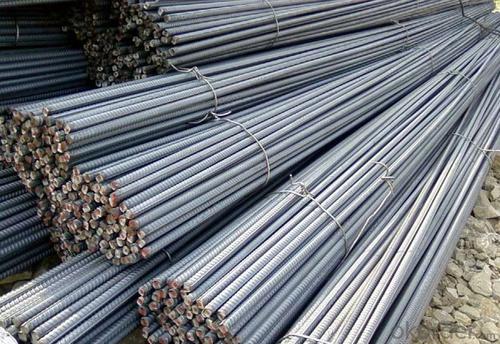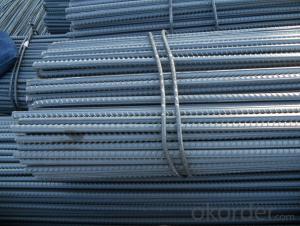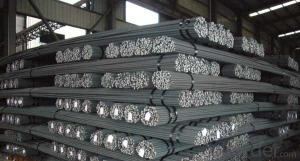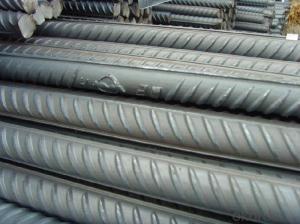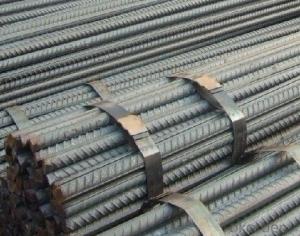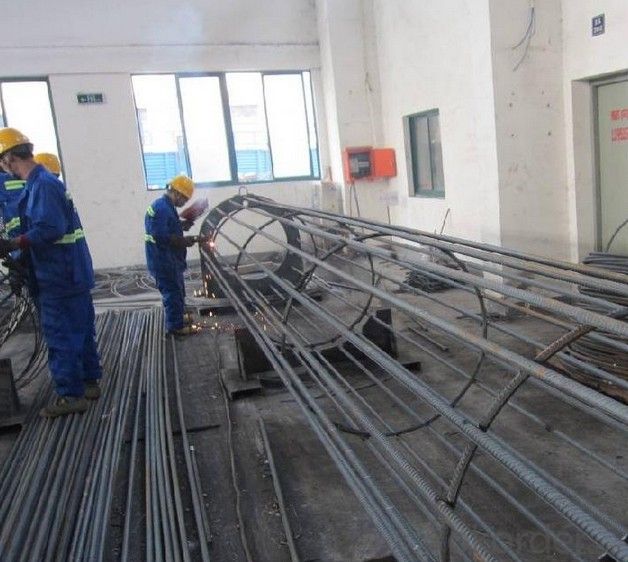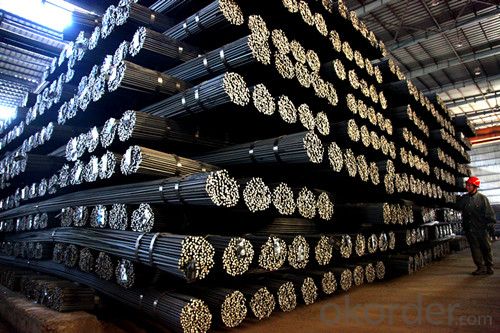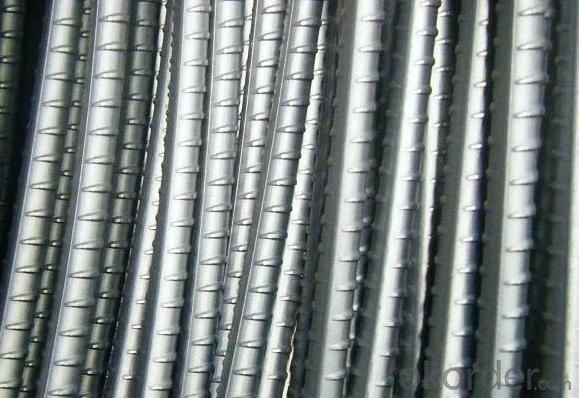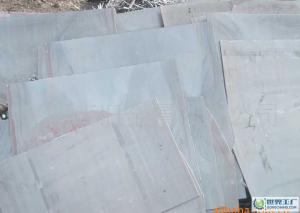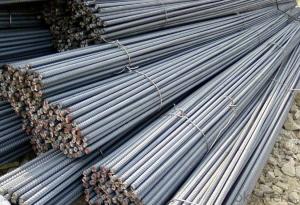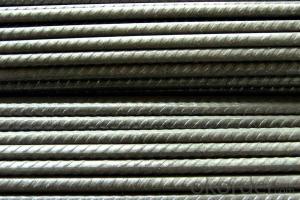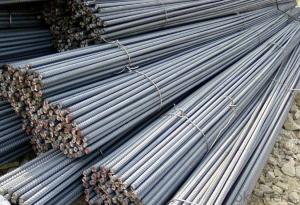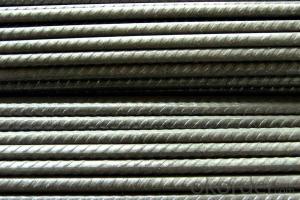High quality hot rolled deformed bar 6mm-50mm ASTM ou BS4449
- Loading Port:
- Tianjin
- Payment Terms:
- TT OR LC
- Min Order Qty:
- 25 m.t.
- Supply Capability:
- 20000000 m.t./month
OKorder Service Pledge
OKorder Financial Service
You Might Also Like
Deformed Bar Details:Product Description:Specifications of HRB400 Deformed Steel Bar:StandardGBHRB400Diameter6mm,8mm,10mm,12mm,14mm,16mm,18mm,20mm,22mm,25mm,28mm,32mm,36mm,40mm,50mmLength6M, 9M,12M or as requiredPlace of originHebei, China mainlandAdvantagesexact size, regular package, chemical and mechanical properties are stable.TypeHot rolled deformed steel barBrand nameDRAGON Chemical Composition: (Please kindly find our chemistry of our material based on HRB500 as below for your information) GradeTechnical data of the original chemical composition (%)CMnSiSPVHRB400≤0.25≤1.60≤0.80≤0.045≤0.0450.04-0.12Physical capabilityYield Strength (N/cm²)Tensile Strength (N/cm²)Elongation (%)≥400≥570≥14 Theoretical weight and section area of each diameter as below for your information: Diameter(mm)Section area (mm²)Mass(kg/m)Weight of 12m bar(kg)628.270.2222.664850.270.3954.741078.540.6177.40412113.10.88810.65614153.91.2114.5216201.11.5818.9618254.52.002420314.22.4729.6422380.12.9835.7625490.93.8546.228615.84.8357.9632804.26.3175.723610187.9998.884012579.87118.4450196415.42185.04 Usage and Applications of HRB400 Deformed Steel Bar: Deformed bar is widely used in buildings, bridges, roads and other engineering construction. Big to highways, railways, bridges, culverts, tunnels, public facilities such as flood control, dam, small to housing construction, beam, column, wall and the foundation of the plate, deformed bar is an integral structure material. With the development of world economy and the vigorous development of infrastructure construction, real estate, the demand for deformed bar will be larger and larger.. Packaging & Delivery of HRB400 Deformed Steel Bar: Packaging Detail: products are packed in bundle and then shipped by container or bulk vessel, deformed bar is usually naked strapping delivery, when storing, please pay attention to moisture proof. The performance of rust will produce adverse effect. Each bundle weight: 2-3MT, or as required Payment term: TT or L/C Delivery Detail: within 45 days after received advanced payment or LC. Label: to be specified by customer, generally, each bundle has 1-2 labels Trade terms: FOB, CFR, CIF
|
- Q: What are the guidelines for inspecting and testing steel rebars on-site?
- To ensure the structural integrity and safety of a construction project, it is essential to conduct on-site inspections and tests on steel rebars. Here are some guidelines to consider: 1. Begin with a visual inspection, checking for any visible defects such as rust, cracks, or deformities. Also, ensure that the rebars' size, shape, and alignment comply with the project's specifications and standards. 2. Keep accurate documentation of the rebars, including their origin, grade, and dimensions. This information will help track compliance with the project's requirements and identify any potential issues. 3. Take representative samples from each batch of rebars for further testing. The number of samples required may vary depending on the project's specifications and regulatory requirements. 4. Verify compliance with the project's requirements by measuring the rebars' length, diameter, and shape. Ensure that they are within the permissible limits and not bent or twisted excessively. 5. Conduct a chemical composition analysis to ensure that the rebars meet the specified standards. This analysis typically involves testing for elements like carbon, sulfur, phosphorus, and manganese. 6. Determine the rebars' mechanical properties through tensile and yield strength tests. This testing helps ensure that the rebars can withstand the expected loads and stresses during construction. 7. Assess the rebars' ductility and ability to withstand bending without fracture or significant deformation through a bend test. This test is particularly important for rebars used in reinforced concrete structures. 8. Use ultrasonic testing techniques to detect any internal defects that may affect the rebars' performance. These defects, such as voids, cracks, or inclusions, may not be visible to the naked eye. 9. Evaluate the rebars' resistance to corrosion, especially in moisture or chemically exposed environments. This assessment may involve techniques such as measuring corrosion potential or analyzing chloride content. 10. Keep comprehensive records of all inspection and testing activities, including test results and any deviations from the project's specifications. This documentation acts as evidence of compliance and aids in future audits or quality control checks. It is important to note that these guidelines provide a general framework for on-site inspection and testing of steel rebars. Always refer to specific project requirements, industry standards, and local regulations for a more detailed and accurate procedure.
- Q: What is the difference between rebar bolts and steel bars?
- This question can only be answered: "material should not be compared to components.". Insist on saying the difference, one is the material, and the other is the component.You may ask the difference between soil nail and anchor bar, but the topic is not. I shall be glad to answer another question!
- Q: What are the safety considerations when handling steel rebars?
- When handling steel rebars, it is important to observe several safety considerations. Firstly, workers should always wear appropriate personal protective equipment (PPE) such as gloves, safety glasses, and sturdy footwear to protect against potential injuries. Secondly, it is crucial to ensure proper lifting techniques and use mechanical aids when necessary to avoid strain on the body. Additionally, workers should be cautious of the sharp edges and protruding ends of the rebars to prevent cuts and puncture wounds. Regular inspection of the rebars for defects, such as rust or bending, is also essential for maintaining a safe work environment. Lastly, proper storage and stacking procedures should be followed to prevent rebars from falling, causing injuries to workers or damage to property.
- Q: Can steel rebars be used in the construction of road bridges or flyovers?
- Steel rebars are indeed applicable in the construction of road bridges or flyovers. Owing to their remarkable strength and durability, they are widely utilized as reinforcement in concrete structures such as bridges and flyovers. By fortifying the concrete, these rebars amplify its structural integrity and load-bearing capacity, making it capable of withstanding heavy traffic loads and enduring the forces encountered by road bridges and flyovers. Furthermore, steel rebars furnish heightened resistance to corrosion, a vital attribute in bridge construction where exposure to environmental factors is prominent. In summary, the utilization of steel rebars guarantees the structural stability, longevity, and safety of road bridges and flyovers.
- Q: How do steel rebars prevent cracks in concrete structures?
- Steel rebars prevent cracks in concrete structures by providing tensile strength to the concrete. When the concrete dries and hardens, it becomes strong in compression but weak in tension. The presence of steel rebars within the concrete adds tensile strength, allowing the structure to resist cracking under tensile stresses. The rebars act as reinforcement, absorbing and distributing the tensile forces throughout the concrete, preventing the formation and propagation of cracks.
- Q: What is the role of steel rebars in basement wall construction?
- The role of steel rebars in basement wall construction is to provide reinforcement and structural support to the concrete wall. Steel rebars, also known as reinforcing bars, are typically made of carbon steel and are placed in the concrete before it is poured. The rebars are strategically positioned within the concrete to add strength and stability to the wall. They help to distribute the load and forces that the wall may encounter, such as soil pressure or lateral forces from the surrounding environment. This reinforcement prevents the wall from cracking or collapsing under these external pressures, ensuring its durability and structural integrity. In addition to reinforcing the basement wall, steel rebars also help to control shrinkage and expansion of the concrete due to temperature changes. By providing a framework within the wall, the rebars help to limit the formation of cracks and maintain the overall stability of the structure. Overall, the presence of steel rebars in basement wall construction significantly enhances the strength and durability of the concrete wall. They play a crucial role in ensuring the integrity of the structure and protecting it from potential damage or failure.
- Q: Can steel rebars be used in buildings with high architectural requirements?
- Yes, steel rebars can be used in buildings with high architectural requirements. Steel rebars are widely used in construction due to their strength, durability, and versatility. They provide structural integrity and reinforcement to concrete structures, making them suitable for a wide range of architectural designs and requirements. Steel rebars can be used in various architectural elements, such as beams, columns, walls, slabs, and foundations. They can be bent, shaped, and welded to meet specific architectural designs, allowing for intricate and complex structures. Additionally, they can be customized in terms of size, length, and spacing, ensuring that they meet the architectural requirements of the building. Moreover, steel rebars are resistant to fire, corrosion, and extreme weather conditions, making them suitable for buildings with high architectural requirements in terms of safety and durability. They provide a long-lasting solution, ensuring that the architectural vision and design can be preserved for years to come. In conclusion, steel rebars can definitely be used in buildings with high architectural requirements. Their strength, durability, versatility, and customization options make them an ideal choice for ensuring structural integrity while meeting the aesthetic and design requirements of the building.
- Q: What are the different grades of steel rebars used in bridge construction?
- The different grades of steel rebars used in bridge construction vary depending on the specific requirements and design specifications of the bridge. Common grades include Grade 40, Grade 60, and Grade 75. These grades indicate the minimum yield strength of the steel rebar, with higher grades offering greater strength. The choice of grade depends on factors such as the anticipated loads, span length, and structural design of the bridge.
- Q: What is the role of steel rebars in preventing structural failures?
- The role of steel rebars in preventing structural failures is crucial and integral in the construction industry. Steel rebars, also known as reinforcing bars, are used to reinforce and strengthen concrete structures, ensuring their durability and ability to withstand various forces. One of the primary functions of steel rebars is to enhance the tensile strength of concrete. While concrete is an excellent material for compression, it is relatively weak in tension. The introduction of steel rebars into concrete structures helps to counter this weakness by providing resistance to tensile forces. Steel rebars act as a reinforcement, absorbing and distributing tensile stresses throughout the structure, preventing cracks and fractures from developing and ultimately preventing structural failures. Additionally, steel rebars play a crucial role in preventing structural failures by improving the overall structural stability. By reinforcing concrete, rebars enhance the structural integrity and increase the load-bearing capacity of the structure. This allows the structure to withstand heavier loads and forces, such as those caused by natural disasters, extreme weather conditions, or human activities. Steel rebars are also essential in preventing structural failures caused by corrosion. Concrete structures are exposed to various environmental factors that can lead to corrosion of the reinforcing steel, such as moisture, chemicals, and salts. As steel rebars are typically coated or protected with anti-corrosive materials, they provide a barrier against corrosion, ensuring the long-term durability and integrity of the structure. Furthermore, steel rebars aid in preventing structural failures by providing stability during construction. During the construction process, steel rebars are strategically placed within the concrete forms to provide reinforcement at critical points and areas prone to high stress. This ensures that the structure is stable and can withstand the loads and forces imposed during and after construction. In summary, the role of steel rebars in preventing structural failures is multi-faceted. They enhance the tensile strength of concrete, increase structural stability, prevent corrosion, and provide stability during construction. By reinforcing the concrete, steel rebars significantly contribute to the overall strength, durability, and safety of structures, ultimately preventing structural failures and ensuring the longevity of the built environment.
- Q: Can steel rebars be used in structures with high aesthetic requirements?
- Yes, steel rebars can be used in structures with high aesthetic requirements. While steel rebars are primarily used for their strength and durability, they can also be designed and incorporated in a way that meets aesthetic requirements. Rebars can be shaped, bent, or painted to match the desired aesthetic of the structure. Additionally, they can be hidden within the structure or covered by other materials to maintain a clean and visually appealing appearance. With careful planning and design, steel rebars can be successfully used in structures with high aesthetic requirements without compromising their functionality or visual appeal.
Send your message to us
High quality hot rolled deformed bar 6mm-50mm ASTM ou BS4449
- Loading Port:
- Tianjin
- Payment Terms:
- TT OR LC
- Min Order Qty:
- 25 m.t.
- Supply Capability:
- 20000000 m.t./month
OKorder Service Pledge
OKorder Financial Service
Similar products
Hot products
Hot Searches
Related keywords
